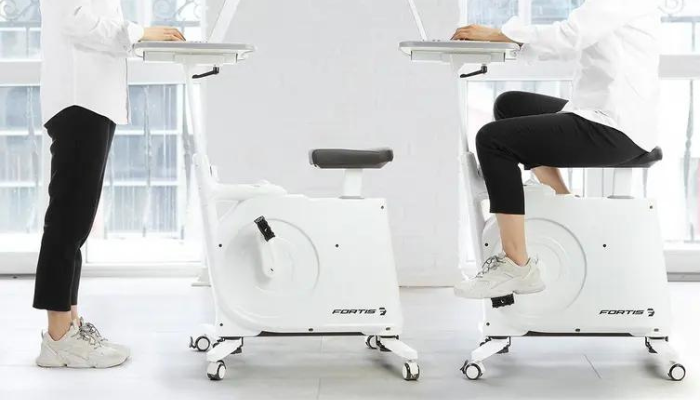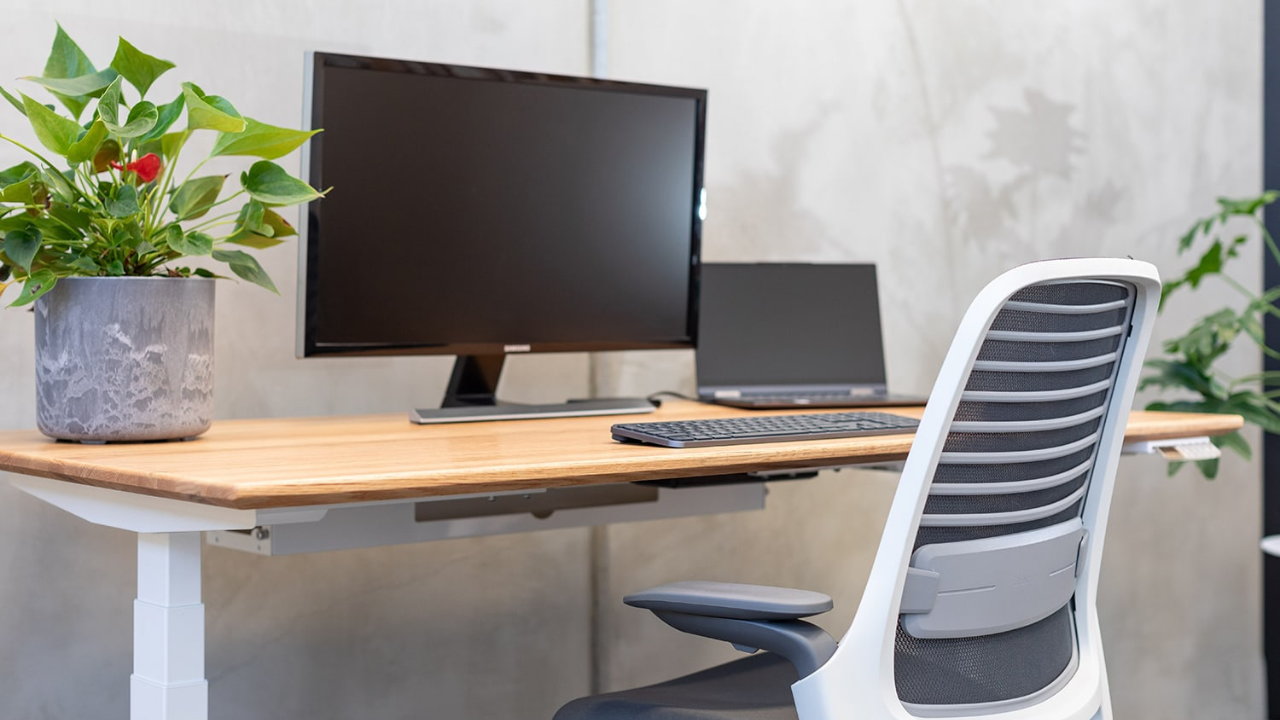Our working environment and workspaces continue to evolve as we find more evidence that our present way of work negatively affects our health. Over the last two decades, various research and resources have been dedicated to the health risks of sitting for 40 hours weekly. The phrase “sitting is the new smoking” caught on, as health risks such as cancer, heart disease, diabetes, and depression were all linked with long hours of sitting.
The high demand for standing desks is primarily attributed to this new evidence. But does sitting really have such severe consequences on our health? And are standing desks the solution to long-hour sitting?
We will discuss in this guide if standing desks are worth it and how best to use them if you ever decide to go that route. Let’s get into it!
Are Standing Desks Really Worth the Hype?

What makes sitting for long risky to your health? The human body is naturally not designed to stay in a single spot for long. And while we are likely to move around periodically during work to grab lunch or talk to a colleague, these movements fall short of the energy required by the body to keep blood moving, aid digestion, and metabolise nutrients. These prolonged sittings also put strains on our neck and back. Further research has shown that people who sit for more than eight (8) hours daily risk dying of similar causes as smoking and obesity.
Consequently, some experts have suggested standing desks as the new solution to sitting for long as the human body is much more active when standing than sitting.
The challenge with swapping these activities is they are both sedentary behaviours. A study found that the number of calories burned during standing was only slightly higher than that of sitting, making the latter not much of a solution to the issue of prolonged sitting. And while standing reduces neck and lower back strains associated with sitting, you’re also easily fatigued from long-standing.
So are they worth it? While there is little to separate both activities, the benefits of standing desks become more pronounced when they are coupled with frequent walks and movements away from the desk, which is uncommon with sitting desk users.
So while standing desks can be a great addition to your working space and health, it is imperative to break tasks into time frames that allow you to have regular moving breaks. Studies show that regular, moderately intense physical activities between sixty (60) and seventy-five (75) minutes can help counter the effect of sedentary behaviour.
Pros & Cons of Using a Standing Desk
Let’s delve into the benefits and challenges of standing desks over traditional sitting desks.
Pros: About Standing Desks
Below are some of the benefits of using a standing desk.
1. Improved Health
According to experts, you will burn 24 more calories in three hours of standing than sitting. Standing desks also reduce neck strains since your muscles don’t tighten for long periods. While standing desks can also reduce lower back pain, it primarily depends on how long you stand. You are also likely to avoid health complications like obesity, diabetes, and cardiovascular when you use standing desks appropriately.
2. More Control
Most standing desk users experience more control over their workspace than sitting desk users. Height Adjustable standing desks allow workers to choose between sitting and standing at various points during work hours. This behaviour helps strike an excellent balance between sitting and standing for too long. Adjustability also means that users can adjust desks to heights that work comfortably and avoid strains.
3. Improved Productivity
Standing desks can also improve productivity. Numerous studies confirm that sitting for long can reduce brain function, slowing down productivity as you approach the final third of an eight-hour work day. Siting and standing regularly have the opposite effect as the heart pumps more blood to the brain during these movements, which helps boost your productivity and reduce fatigue.
4. Improve Collaboration
Standing desks can contribute to the overall culture and workplace environment when used in work environments. Discussing ideas, reaching out to colleagues, and engaging coworkers are easier. Standing desks can also improve collaboration and enhance flexibility in the right working environment.
Cons: The Hardly Spoken About Downsides
While standing desks offer good margins of health and productivity benefits over sitting desks, some adverse effects are worth considering.
1. Adverse health effects
Standing desks, when misused, can pose risks similar to sitting desks. People who work at their standing desks for prolonged periods without much movement are likely to experience leg and foot pains. This is due to upper body pressure on the knees and hips. While intermittently lifting either leg can help ease the stress, it also can affect your standing posture, causing you more problems down the line.
Standing for too long can also lead to a health complication known as varicose veins. This results from blood collected in your leg veins for extended periods. It’s advisable to avoid standing for more than four hours continuously at a standing desk.
Standing desks can also increase the risk of injury in a workspace. Because of their many moving parts, you are likely to injure yourself when you lose focus. This problem is typical of users who prefer exercising-standing desks over traditional ones.
2. Insufficient education on how to use
Most people adopting standing desks barely take time to read the challenges and appropriate use cases for these desks. As a result, many misuse them, causing further damage to their health. Standing desks do not replace exercise. Very few calories are burned from standing compared to sitting. Whiles the former can be more beneficial, it is essential to combine standing with regular movement breaks and exercises that allow ease of blood flow, as well as reduce the tension in your muscles.
3. Increased associated cost
Standing desks are overall more expensive than sitting desks. And while this is bearable, its many moving parts make it liable to fault and breakages. It’s crucial to look out for good warranty covers when purchasing a standing desk.
Top 3 Common Types of Standing Desks
Now that you know how standing desks can contribute to your overall health and its associated challenges, let’s look at the various types. Some of these offer extra perks and features that allow you to use them as sitting desks. Others help you break sedentary behaviours, contributing to your overall health. Here are the most standard types of standing desks available.
1. Standing Only Desks

Standing only desks are fixed height standing desks. They offer very little ergonomically and have fewer features. Standing only desks have a standard height that is unadjustable. Ensure that the desk height fits your standing position before purchase. If unsure, use FlexiSpot’s desk height calculator to decide the right standing desk height for your workspace. You should also consider the surface space and portability of the standing-only desks you buy.
2. Height-Adjustable Standing Desks

Height-adjustable standing desks are another form of standing desk that gives you control over the height of the standing desk. Unlike standing-only desks, users can manipulate the height of their standing desks. Two types of height-adjustable desks exist; mechanically adjustable standing desks and electrically adjustable standing desks. Mechanically adjustable standing desks offer manual adjustments. Since the process is usually not smooth, it’s usually set at a single height and readjusted only when necessary. Electrically adjustable standing desks on the hand are typically adjustable with a button. These desks use an electric lift that allows you to raise or lower your desk's height with a push of a button. Also worth mentioning here are convertibles. These are not traditional standing desks but accessories that can transform your sitting desk into a standing desk.
3. Exercise Standing Desks

Exercise standing desks are the latest additions to standing desks. Typical examples are standing desk treadmills and bikes. Exercise-standing desks incorporate moderate activities into your working hours and help avoid pedantic behaviours. Others come with ergonomic functionalities such as adjustability and the option to use the desk without the attached exercising unit. While these activities contribute more to your health when working with standing desks, they are also liable to cause backache and can increase your workspace injury rate.
Should You Use a Standing Desk?
The decision of whether a standing desk or a sitting desk would best cater to your needs is only yours to make. Of course, anyone can use a standing desk; they offer extra perks that improve productivity and health overall.
It is essential to reecho, however, that while standing desks can benefit you, you are likely to achieve similar results from your sitting desks if you take regular intermittent breaks to perform moderate exercises. We recommend breaking your eight-hour work schedule into six parts, allowing you to perform at least ten minutes of moderate exercising periodically. Exercising-standing desks may do the trick when you cannot spare those minutes.
If you’re unsure about it, speak to your colleagues or friends who have used these products and seek their experiences and challenges. Though we are different, they may be able to offer insights other than what has been already stated here that help you decide.
How Best to Use Standing Desks
When you fail to apply proper ergonomics to your standing desks, you risk severe health challenges. Some of the most important factors to consider when using standing desks include the following.
1. Adjust your standing desks correctly.
The first step to using any desk, sitting or standing, is to ensure proper adjustment to your height and eye levels. This is crucial to avoid unnecessary strains and bad posture that can lead to future complications. Standing desks users should set their desks paying attention to the following cues:

- Standing desk heights should be adjusted to elbow level, ensuring you do not strain your elbows from unrest.
- Your desk should help you relax your shoulders while keeping your neck straight. Unrelaxed necks and shoulders could cause further injuries to your spine and lower back. Where keeping your standing desk at elbow level forces you to raise your shoulders or strain your neck, consider buying a monitor stand to complement the standing desk further.
- Your wrists should be at surface level with the desk surface. When your wrists do not evenly rest on the desk surface, even with sitting desks, you’re prone to developing carpal tunnel syndrome due to the pressure on the median nerve.
2. Balance boards can be helpful accessories.
If you’re having difficulty keeping your posture when using your standing desk, we recommend purchasing a balance board. Balance boards help you train your balance and keep your posture for a longer time. They are also fun and can significantly improve your experience with standing desks. Consider its tilting degree, design, and board size when purchasing a balance board. Ensure they fit correctly and do not add additional strain to your workspace.
3. Sit-stand desks are a better option.
We’ve established that sitting and standing for long can harm your health. Finding the balance with sit-stand desks can be highly beneficial. Alternating between sitting and standing at regular periods reduces the chances of experiencing the complications associated with either extreme. While studies are still underway, many experts recommend dividing your 8-hour work day into four parts sitting and standing.
4. Use exercise with your standing desks.
While exercising increases the risk of workplace injury, it helps keep your body and brain active more than prolonged standing. Various exercise options exist; you might consider a folding exercise bike or a treadmill that fits nicely under the desk, of course, you might find it better to get a desk attachment for a treadmill.
5. Purchase an anti-fatigue mat.
Anti-Fatigue mats were designed to ease stress and the associated fatigue of standing for prolonged hours. These mats are typical at jobs requiring long-standing hours, such as product line and counter workers. Researchers confirm that anti-Fatigue mats are a necessary accessory to your home office if you plan on using your standing desks far beyond the recommended times.
6. Pair with an ergonomic chair
You can easily waste the benefit of a standing desk by pairing it with an uncomfortable chair for those periods when you sit; ensure you have a proper ergonomic chair. As mentioned above, nobody should stand all day long, and it is best to alternate.
7. Take intermittent breaks.
We cannot stress this enough. Regardless of your workload or deadlines, take intermittent breaks. They contribute to your health, boost productivity, and improve mood. Taking little breaks can help you more than just sitting or standing for long periods.

Ready to Own One?
While there is still more to uncover about standing desks and if they are truly worth investing in, most researchers and experts consider them to be more beneficial to our overall health than sitting desks.
We hope this guide helped you understand the fuss and scope of standing desks, how to use them like a pro and decide for yourself if they are worth investing in.
Check out our guide below for a comprehensive evaluation of the best standing desks available in Australia.








